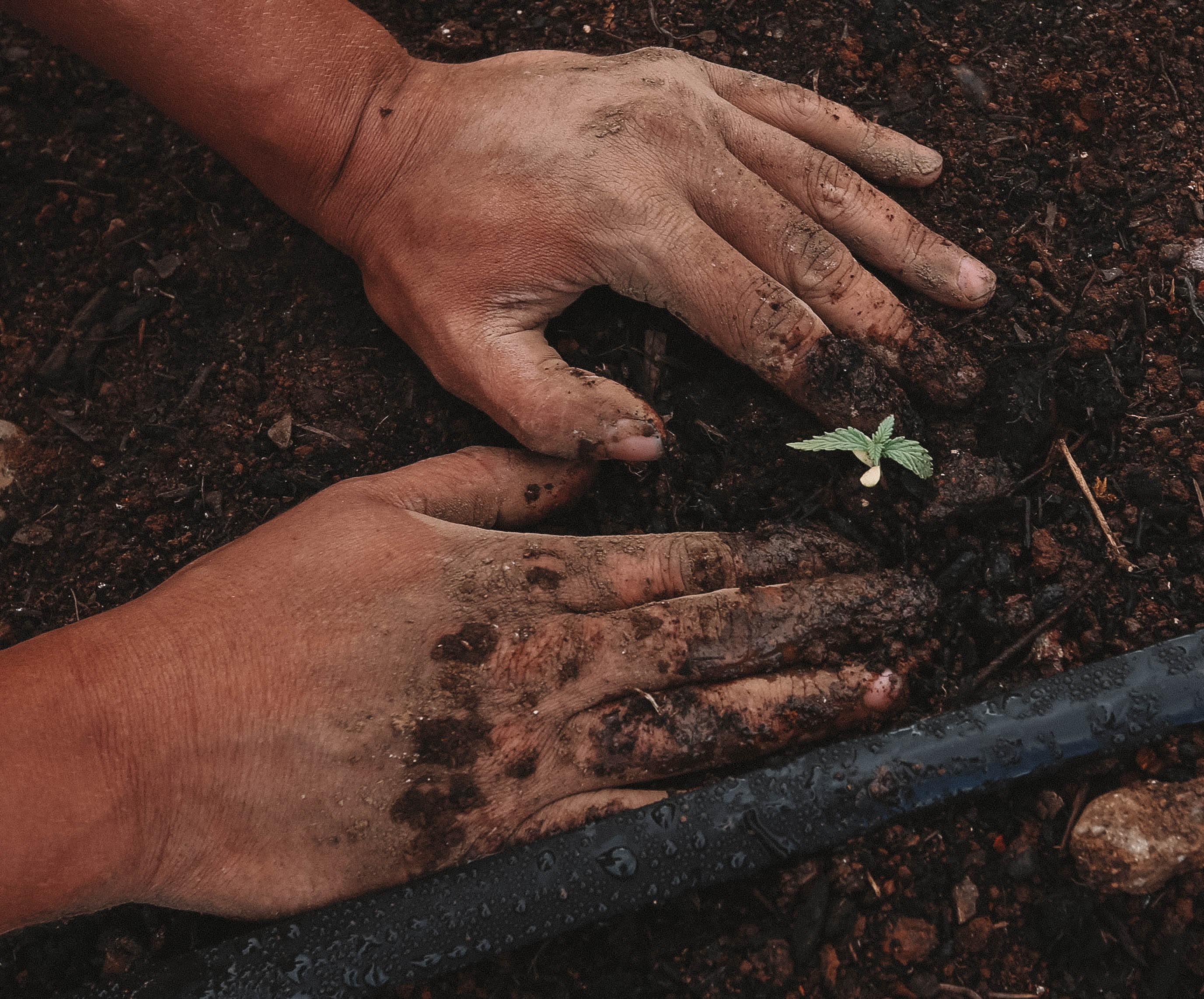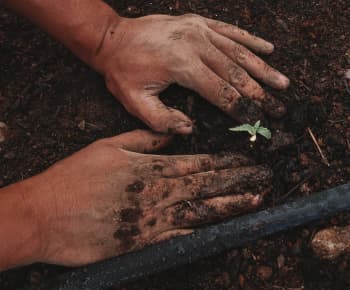Celebrating Women in STEM
“Follow your curiosity”

To mark the International Day of Women and Girls in Science , two of our academics speak about their research careers and how they ended up using their STEM interests to tackle climate change.
Build food security amid changing environments with crop science
Dr Nadia Radzman is a plant biologist. She’s an expert in legume biology, i.e., “anything that’s got to do with beans!...I’m a little bit obsessive about it.”
“I initially wanted to do something with virology…I didn’t even consider plant biology as something I wanted to pursue,” said Dr Radzman.
However, after finding herself allocated to a plant biology lab during her second summer of undergrad, she wound up falling in love with legumes.
Now she uses her background in chemistry and molecular biology, and her love for beans, to secure a brighter, well-nourished future for people across the planet.
“Within the context of climate change, [legumes] will become very important in the future,” said Dr Radzman.
Her work investigates how the important plant nutrient, nitrogen, can be acquired naturally by the plant from the air (“fixed”), without the use of polluting synthetic fertilisers.
She’s also interested in how plants can be used to breathe in the climate-changing greenhouse gas, carbon dioxide, to trap (“sequester”) carbon underground.
“Legumes can mutually associate with very specific bacteria in the soil through symbiosis and form these structures on the roots called nodules…these nodules fix nitrogen from the air into a form that can be utilised by the plants,” said Dr Radzman.
“Because nitrogen and carbon are very strongly correlated, if you have a higher fixation of nitrogen it also correlates with a higher sequestration of carbon too.”
“When we want to fix nitrogen from the air we have to use the Haber-Bosch process, which is high temperature and a lot of fossil fuels…but plants can do it in just ambient temperature.”
Dr Radzman's latest project is applying her findings about these underground roots structures into the aboveground shoots. She’s interested in how a changing environment will influence the shoot, which is the part of the plant that produces the beans.
“I figured out that there are aspects of [nodules] that can be translated into the shoot…and the shoot is important in terms of food security, and when we talk about climate change.”
Dr Radzman is also one of the first batch of King’s College Research Associates in their entrepreneurship lab. Her start-up idea is to improve the technology available to transfer genetically modified plant tissue into field-ready growing plants, which is one of the most challenging aspects of engineering crops.
She was inspired to scale-up her science to industry after being approached by a few African NGOs asking how they can adapt their agriculture to the increasingly extreme dry seasons due to climate change.
“Native African legume crops are very drought tolerant, but these crops are usually forgotten or neglected…these crops need to have a higher yield to support the population.”
“Because of climate change, we need to improve our crops faster and cheaper, especially for the Global South. To do that, we will need new technologies,” said Dr Radzman.

“Having a role model is important. It can be a motivation that someone has made it, so I can do it too.”
Dr Nadia Radzman
Creating safe and sustainable batteries for the energy transition
Dr Svetlana Menkin is interested in battery interfaces. Her research is all about next-generation batteries, which involve using materials such as Sodium and Calcium ions, or Zinc, to store energy.
These batteries are vital for green transition to store the production of renewable energy, so that we can use our captured solar energy from the day well into the night.
But what is a battery interface? What is a battery? Why does it matter? Dr Menkin explains:
“In batteries we have cathodes and anodes (two electrodes), which are connected by electrolytes, which are absorbed in a separator. This electrolyte allows ions to pass from one side to another, but not the electrons.”
This transport of electrons and ions creates what’s known as a “charge transport.” The purpose of batteries is to store a charge, i.e. store electrical energy, which can then be “discharged” to power our devices.
“When you charge a battery, you ‘put in’ electrons from the circuit, which forces the ions from one electrode to the other. When you discharge, you let these ions (this ‘charge’ that you’ve passed) go back [to the other electrode] which then gives up the electrons you stored. You then use these electrons for the device...and this is how you store energy in a battery.” Eureka!
“Batteries are all about controlling how this charge is transported,” said Menkin. “Between the electrodes, in the electrolyte, the charge should pass…but typically the electrodes develop a layer at the interface [between the electrodes and the electrolytes],” said Menkin, which could happen for example as a product of a chemical reaction of the electrolyte with the anode.
“This is very critical for the battery because this will determine performance: how fast it can charge, safety of the battery, the degradation/ how many cycles it can do.”
These next-generation batteries are more sustainable than alternatives such as Lithium-ion batteries. “Calcium is one of the most abundant elements…it is three magnitudes more abundant than lithium. Lithium is only found in particular places, and so it's more energy intensive to move it about from place to place. The methods to extract Lithium from sources are also not very environmentally friendly,” said Dr Menkin.
The challenge with these next-generation batteries, however, is that this interface becomes very unstable. When unchecked, this instability can lead to short-circuits and battery fires.
Dr Menkin aims to understand these interfaces so she can improve battery safety, and hence the availability of more sustainable batteries to industry.
“Eight years ago calcium-rechargeable batteries were considered impossible…so it's very new, but we will try.”

Mentoring Women and Girls in Science
When asked about what first sparked their interest in STEM, Dr Radzman and Dr Menkin both noted female teachers in their early education.
“Towards the end of high school, I had a chemistry teacher. I remember one class where she explained to us the structure of diamonds, and I was fascinated by how diamonds and coal are made of the same carbon atoms but it is the structure that makes them so different…I was inspired by how excited she was. This was when it clicked: I was going to study chemistry,” said Dr Menkin.
“I had a very good high school teacher…in my high school, there were not a lot of girls who wanted to pursue science. But she was really, really encouraging, and motivated me to pursue [my interests in STEM],” said Dr Radzman.
“Having a role model is important,” said Dr Radzman. It can be a motivation that someone has made it, so I can do it too.”
“Each step that I made, to bring me to where I am now, I had somebody who was there to support me and was there to tell me ‘yes this is possible for you,’” said Dr Menkin.
Radzman’s final piece of advice? “Follow your curiosity...take up your space, and stand your ground.”
“We see that female candidates, if they see that they are almost hitting the criteria, they don’t apply. Male candidates, [who are] not eligible, [they] apply. I think this is the critical point: you need somebody to tell you that it is possible for you,” said Dr Menkin.
“If you look at something and you can imagine yourself being happy there, apply. Go for it! …if you wonder whether it's possible for you, it is,” said Dr Menkin.
The International Day of Women and Girls in Science is a campaign to promote full and equal access and participation of women in Science, Technology, Engineering and Mathematics (STEM).
Applications to join Dr Menkin’s lab as a PhD student are open now until the end of the month. Find out more information about how to apply here.
Published 11 February 2024
Images: Nick Saffell
The text in this work is licensed under a Creative Commons Attribution 4.0 International License

Cambridge Zero is the University of Cambridge’s ambitious climate change initiative, harnessing the power of research to tackle climate change at one of the top global research universities in the world.








